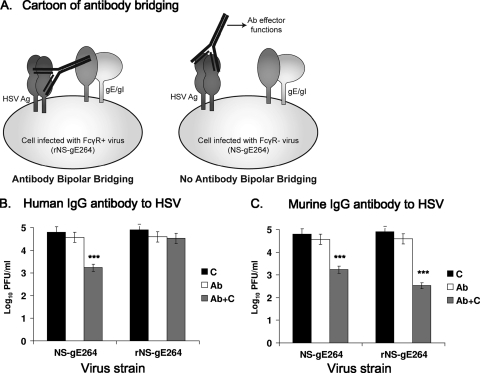FIG. 5.
Antibody-dependent complement neutralization. (A, left) HSV-1 IgG antibody binds to HSV-1 antigen by the Fab domain, and the Fc domain of the same antibody molecule binds to the HSV-1 FcγR (gE/gI). (Right) The cell is infected with NS-gE264, which expresses gE/gI but fails to form an FcγR. HSV-1 IgG antibody binds to HSV-1 antigen by the Fab domain, but the Fc domain fails to bind to the FcγR (gE/gI). (B) NS-gE264 and rNS-gE264 were incubated with 5% human serum as a source of complement (C) from an HSV-1- and HSV-2-seronegative donor, or incubated with human IgG antibody to HSV (Ab) at a concentration that neutralizes virus by ∼50%, or with antibody and complement (Ab+C). ***, P < 0.001 for comparison of Ab+C with Ab alone or C alone. (C) NS-gE264 and rNS-gE264 were incubated with human complement as described above, or with murine IgG antibody to HSV-1, or with antibody and complement. ***, P < 0.001 for comparison of Ab+C with Ab alone or C alone for NS-gE264 and rNS-gE264. Results in panels B and C are the means and standard deviations of three experiments.

